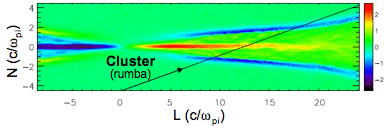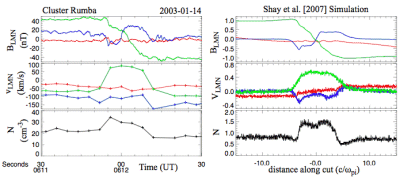Cluster result impacts future missions
23 January 2008
Magnetic reconnection is a universal process able to drive explosive phenomena such as solar flares. At the heart of this process is a small zone called the electron diffusion region, where reconnection is thought to be triggered. In a recent article, scientists report the first observational evidence for the overall size of this region and find that it is 300 times larger than previously thought. This means that future missions will have a much better chance of detecting and resolving this region than previously estimated, profoundly impacting mission design and scientific operations.| Movie 1. Magnetic field lines (white) on a colour contour plot of electron flow speed, showing the electron diffusion region's size (red, yellow and green) evolve. Dr. Michael Shay, University of Delaware, USA |
Space is filled with plasma (an ionized gas composed of ions and electrons, globally neutral) and threaded by magnetic fields. These magnetic fields store energy, which can be explosively released in a process called magnetic reconnection. This physical process plays a key role in numerous astrophysical phenomena: star formation, solar flares and intense aurora to name a few. On Earth, it is a mechanism that can disrupt the efficient production of electricity in controlled fusion reactors.
During reconnection, magnetic field lines of opposite polarity annihilate, converting magnetic energy into particle energy. The process begins in a small electron diffusion region where a kink in the newly reconnected lines produces large-scale high-velocity jets of plasma flowing outward .
"Understanding the structure of the diffusion region and its role in controlling the rate at which magnetic energy is converted into particle energy remains a key scientific challenge," says Dr. Michael Shay, University of Delaware, USA.
Theoreticians until very recently thought that the electron diffusion region in the Earth's magnetosphere was a 'tiny' region of width ~2 km and length ~10 km. This meant that, in the vastness of space, the chance of a spacecraft encountering this region was exceedingly small, even though already crossed and studied (e.g. Scudder et al., 2002; Mozer et al., 2003, 2005a, 2005b, Xiao et al., 2006).
But as computer power has increased, theorists made their two dimensional (2-D) simulation domains larger. They then discovered unexpectedly that the electron diffusion region is much more elongated than seen in earlier simulations, a bit like stretched chewed gum (movie 1) [Shay et al., 2007; Karimabadi et al., 2007]. However, the theorists still can't tell how long this layer truly is because it continues to lengthen as the simulation box is made bigger and bigger. Is this new simulation finding real? Is such an elongated layer even stable, especially in the real 3-D world?
 |
| Image 1. Trajectory of Rumba (Cluster-1) overlaid on a numerical simulation of an electron diffusion region in the magnetosheath. The simulated electron flow speed in the diffusion region exceeds the magnetic field line speed, consistent with Cluster observations. Credits: Dr. Tai Phan, SSL, Berkeley University, USA |
On 14 January 2003, the four ESA/NASA Cluster satellites were crossing the magnetosheath, a turbulent plasma region located just outside the Earth's magnetosphere, when they encountered an electron diffusion region. Not only did Cluster confirm the existence of an elongated electron diffusion region (Image 1), but the length observed by Cluster is 3000 km, or 300 times longer than the earlier theoretical expectations and even four times longer than seen in recent simulations. The observations are in excellent qualitative agreement with simulations (Image 2).
"These Cluster observations are very significant since they are the first measurements of the length of the electron diffusion region in the space environment. The finding drastically changes the way we understand the physics of reconnection," noted Dr. James Drake, University of Maryland, USA.
"This discovery of an electron diffusion region 300 times longer than previously thought means future space missions will have a much higher probability of detecting and resolving the electron diffusion region than previously estimated," says Tai Phan, University of California at Berkeley, USA.
Cluster was able to detect the electron diffusion region based on its high-resolution magnetic field, electric field and ion measurements. But to finally understand the fundamental physics of the electron diffusion region (which is ultimately responsible for reconnection), one needs to perform electron measurements with higher time resolution, capable of resolving this thin but long layer. The four spacecraft of the NASA Magnetospheric Multi-Scale mission (MMS) are being designed to make such measurements. This mission is planned for launch in 2014. Following MMS is a mission called Cross-Scale, which comprises 12 spacecraft to simultaneously watch the diffusion region and measure the global consequences of energy released by reconnection. Cross-Scale is currently under study at ESA in collaboration with other space agencies as part of a competitive selection process for the mid-2017 launch slot in ESA's science programme "Cosmic Vision 2015-2025".
"With a much higher probability of encountering the electron diffusion region, we can be confident that these future missions will be able to grasp a full understanding of the magnetic reconnection phenomenon," says Philippe Escoubet, Cluster and Double Star project scientist at ESA.
References
T. D. Phan, J. F. Drake, M. A. Shay, F. S. Mozer and J. P. Eastwood, Evidence for an elongated (> 60 ion skin depths) electron diffusion region during fast magnetic reconnection, Phys. Rev. Let., 99, 255002, doi:10.1103/PhysRevLett.99.255002, 21 December 2007
Related articles
Shay, M.A., J.F. Drake and M. Swisdak, Two-Scale Structure of the Electron Dissipation Region during Collisionless Magnetic Reconnection, Phys. Rev. Let., 99, 155002, doi:10.1103/PhysRevLett.99.155002, 9 October 2007
Karimabadi, H. , W. Daughton and J. Scudder, Multi-scale structure of the electron diffusion region, Geophys. Res. Let., 34, L13104, doi:10.1029/2007GL030306, 11 July 2007
Scudder, J.D. et al., Fingerprints of collisionless reconnection at the separator, I, Ambipolar-Hall signatures, J. Geophys. Res., 107, A10, 1294, doi: 10.1029/2001JA000126, 15 October 2002
Mozer, F.S., S.D. Bale, J.P. McFadden & R.B. Torbert, New features of electron diffusion regions observed at subsolar magnetic field reconnection sites, Geoph. Res. Let., 32, L24102, doi: 10.1029/2005GL024092, 17 December 2005
Mozer, F.S., Criteria for and statistics of electron diffusion regions associated with subsolar magnetic field reconnection, J. Geophys. Res., 110, A12222, doi:10.1029/2005JA011258, 28 December 2005
Mozer, F.S., S.D. Bale, T.D. Phan & J.A. Osborne, Observations of Electron Diffusion Regions at the Subsolar Magnetopause, Phys. Rev. Let., 91, 245002, DOI: 10.1103/PhysRevLett.91.245002, 10 December 2003
Xiao, C.J. et al., In situ evidence for the structure of the magnetic null in a 3D reconnection event in the Earth's magnetotail, Nature Physics, 2, 7, 478-483, doi: 10.1038/nphys342, July 2006
Contact
Main author
Dr. Tai Phan, Space Sciences Laboratory, UC Berkeley, USA
E-mail: phan ssl.berkeley.edu
ssl.berkeley.edu
Phone: +1 (510) 643-5505
Web story author and co-editor
Arnaud Masson, Science Directorate, ESA, The Netherlands
E-mail: Arnaud.Masson esa.int
esa.int
Phone: +31-71-565-5634
Web story co-editors
Philippe Escoubet, Science Directorate, ESA, The Netherlands
E-mail: Philippe.Escoubet esa.int
esa.int
Phone: +31-71-565-4564
Matt Taylor, Science Directorate, ESA, The Netherlands
E-mail: Matthew.Taylor esa.int
esa.int
Phone: +31-71-565-8009



